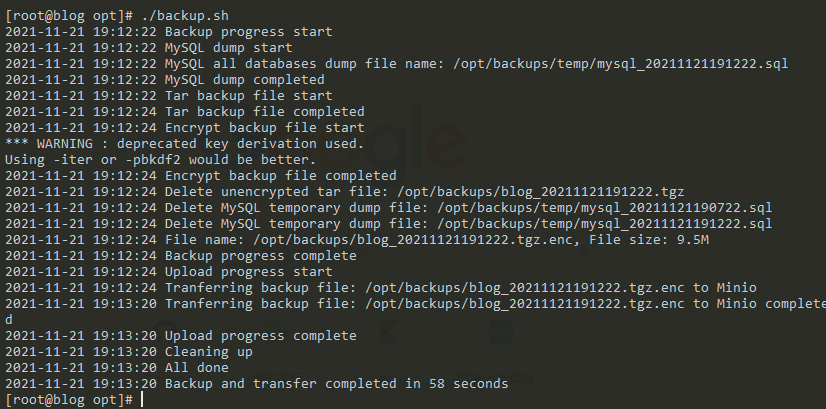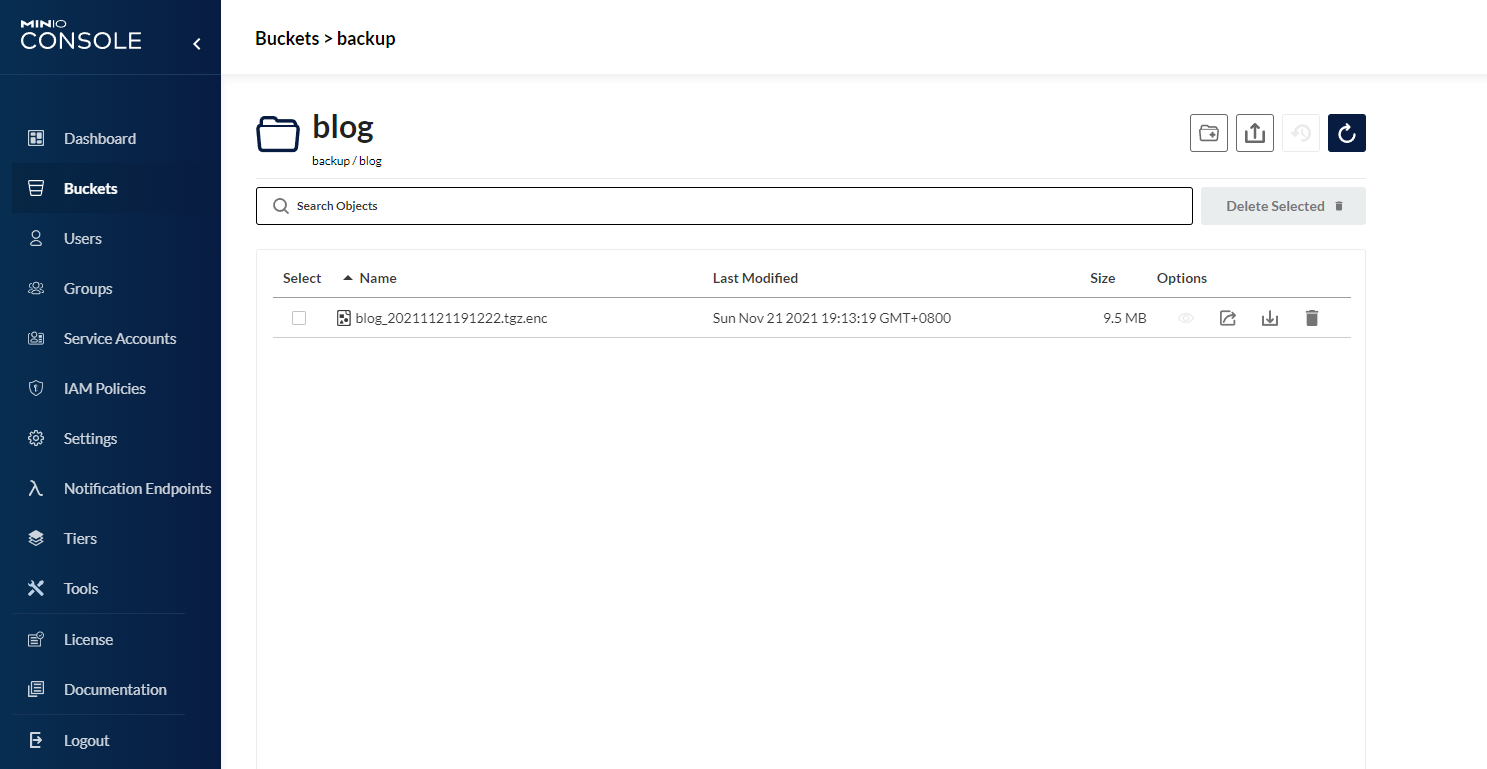刚经历了服务器故障,导致博客内容大部分都丢失的窘境,我今天在重新搭建博客的时候,就顺便将对网站的备份方案进行了完善,主要是以下两点:
- 服务器提供商常态备份
- 核心服务器数据异地备份
第一点没什么好说的,因为我购买的是DigitalOcean家的机器,有个每个月2$的备份选项,直接开启就是了,第二个方案主要是将服务器上的内容异地备份到本地Minio(群晖Docker搭建的)上去了.
自动备份脚本
Rclone
Rclone的官方(https://rclone.org/)介绍如下:
Rclone 是一个命令行程序,用于管理云存储上的文件。它是云供应商 Web 存储界面的功能丰富的替代品。超过 40 种云存储产品支持 rclone,包括 S3 对象存储、企业和消费者文件存储服务以及标准传输协议。
在服务器(Linux/macOS/BSD)上使用以下命令即可快速安装rclone.
curl https://rclone.org/install.sh | sudo bash然后使用rclone config,根据提示一步步去新建Providers即可,我使用的是Minio,直接按照提示或者官方文档(https://rclone.org/s3/#minio)新建即可.

什么是Backup.sh
我在2019年的做过一次备份,我记得是当时是看到一篇文章,https://teddysun.com/469.html ,觉得挺好用,就随手试了一下。通过编写该脚本的作者介绍,有以下几个特点:
- 支持 MySQL/MariaDB/Percona 的数据库全量备份或选择备份;
- 支持指定目录或文件的备份;
- 支持加密备份文件(需安装 openssl 命令,可选);
- 支持上传至 Google Drive(需先安装 rclone 并配置,可选);
- 支持在删除指定天数本地旧的备份文件的同时,也删除 Google Drive 上的同名文件(可选)。
不过我觉得有个特点没写出来,就是对备份的数据进行了加密。
精简成适合自己的Backup.sh
因为我在自己本地的Nas上搭建了一个Minio服务,在使用的过程中发现有些ftp的功能不是我需要到,以及备份的目录功能,和我预期想要的不太一样。于是就自己进行了改造,改造完的脚本内容如下
(2021-11-23新增同步到Google Drive):
#!/usr/bin/env bash
# Copyright (C) 2013 - 2020 Teddysun <[email protected]>
#
# This file is part of the LAMP script.
#
# LAMP is a powerful bash script for the installation of
# Apache + PHP + MySQL/MariaDB and so on.
# You can install Apache + PHP + MySQL/MariaDB in an very easy way.
# Just need to input numbers to choose what you want to install before installation.
# And all things will be done in a few minutes.
#
# Description: Auto backup shell script
# Description URL: https://teddysun.com/469.html
#
# Website: https://lamp.sh
# Github: https://github.com/teddysun/lamp
#
# You must to modify the config before run it!!!
# Backup MySQL/MariaDB datebases, files and directories
# Backup file is encrypted with AES256-cbc with SHA1 message-digest (option)
# Auto transfer backup file to Minio (need install rclone command) (option)
# Auto delete Minio's remote file (option)
[[ $EUID -ne 0 ]] && echo "Error: This script must be run as root!" && exit 1
########## START OF CONFIG ##########
# Encrypt flag (true: encrypt, false: not encrypt)
ENCRYPTFLG=true
# WARNING: KEEP THE PASSWORD SAFE!!!
# The password used to encrypt the backup
# To decrypt backups made by this script, run the following command:
# openssl enc -aes256 -in [encrypted backup] -out decrypted_backup.tgz -pass pass:[backup password] -d -md sha1
BACKUPPASS="123456"
# Directory to store backups
LOCALDIR="/opt/backups/"
# Temporary directory used during backup creation
TEMPDIR="/opt/backups/temp/"
# File to log the outcome of backups
LOGFILE="/opt/backups/backup.log"
# OPTIONAL:
# If you want to backup the MySQL database, enter the MySQL root password below, otherwise leave it blank
MYSQL_ROOT_PASSWORD=""
# Below is a list of MySQL database name that will be backed up
# If you want backup ALL databases, leave it blank.
MYSQL_DATABASE_NAME[0]=""
# Below is a list of files and directories that will be backed up in the tar backup
# For example:
# File: /data/www/default/test.tgz
# Directory: /data/www/default/test
BACKUP[0]=""
# Number of days to store daily local backups (default 7 days)
LOCALAGEDAILIES="7"
# Delete remote file from Googole Drive flag (true: delete, false: not delete)
DELETE_REMOTE_FILE_FLG=true
# Rclone remote name
RCLONE_MINIO_NAME=""
# Rclone remote name
RCLONE_GDRIVE_NAME=""
# Rclone remote buckets name
RCLONE_BUCKETS_NAME=""
# Rclone remote folder name (default "")
RCLONE_FOLDER=""
# Upload local file to Minio flag (true: upload, false: not upload)
RCLONE_FLG=true
########## END OF CONFIG ##########
# Date & Time
DAY=$(date +%d)
MONTH=$(date +%m)
YEAR=$(date +%C%y)
BACKUPDATE=$(date +%Y%m%d%H%M%S)
# Backup file name
TARFILE="${LOCALDIR}""$(hostname)"_"${BACKUPDATE}".tgz
# Encrypted backup file name
ENC_TARFILE="${TARFILE}.enc"
# Backup MySQL dump file name
SQLFILE="${TEMPDIR}mysql_${BACKUPDATE}.sql"
log() {
echo "$(date "+%Y-%m-%d %H:%M:%S")" "$1"
echo -e "$(date "+%Y-%m-%d %H:%M:%S")" "$1" >> ${LOGFILE}
}
# Check for list of mandatory binaries
check_commands() {
# This section checks for all of the binaries used in the backup
# Do not check mysql command if you do not want to backup the MySQL database
if [ -z "${MYSQL_ROOT_PASSWORD}" ]; then
BINARIES=( cat cd du date dirname echo openssl pwd rm tar )
else
BINARIES=( cat cd du date dirname echo openssl mysql mysqldump pwd rm tar )
fi
# Iterate over the list of binaries, and if one isn't found, abort
for BINARY in "${BINARIES[@]}"; do
if [ ! "$(command -v "$BINARY")" ]; then
log "$BINARY is not installed. Install it and try again"
exit 1
fi
done
# check rclone command
RCLONE_COMMAND=false
if [ "$(command -v "rclone")" ]; then
RCLONE_COMMAND=true
fi
}
calculate_size() {
local file_name=$1
local file_size=$(du -h $file_name 2>/dev/null | awk '{print $1}')
if [ "x${file_size}" = "x" ]; then
echo "unknown"
else
echo "${file_size}"
fi
}
# Backup MySQL databases
mysql_backup() {
if [ -z "${MYSQL_ROOT_PASSWORD}" ]; then
log "MySQL root password not set, MySQL backup skipped"
else
log "MySQL dump start"
mysql -u root -p"${MYSQL_ROOT_PASSWORD}" 2>/dev/null <<EOF
exit
EOF
if [ $? -ne 0 ]; then
log "MySQL root password is incorrect. Please check it and try again"
exit 1
fi
if [ "${MYSQL_DATABASE_NAME[@]}" == "" ]; then
mysqldump -u root -p"${MYSQL_ROOT_PASSWORD}" --all-databases > "${SQLFILE}" 2>/dev/null
if [ $? -ne 0 ]; then
log "MySQL all databases backup failed"
exit 1
fi
log "MySQL all databases dump file name: ${SQLFILE}"
#Add MySQL backup dump file to BACKUP list
BACKUP=(${BACKUP[@]} ${SQLFILE})
else
for db in ${MYSQL_DATABASE_NAME[@]}; do
unset DBFILE
DBFILE="${TEMPDIR}${db}_${BACKUPDATE}.sql"
mysqldump -u root -p"${MYSQL_ROOT_PASSWORD}" ${db} > "${DBFILE}" 2>/dev/null
if [ $? -ne 0 ]; then
log "MySQL database name [${db}] backup failed, please check database name is correct and try again"
exit 1
fi
log "MySQL database name [${db}] dump file name: ${DBFILE}"
#Add MySQL backup dump file to BACKUP list
BACKUP=(${BACKUP[@]} ${DBFILE})
done
fi
log "MySQL dump completed"
fi
}
start_backup() {
[ "${#BACKUP[@]}" -eq 0 ] && echo "Error: You must to modify the [$(basename $0)] config before run it!" && exit 1
log "Tar backup file start"
tar -zcPf ${TARFILE} ${BACKUP[@]}
if [ $? -gt 1 ]; then
log "Tar backup file failed"
exit 1
fi
log "Tar backup file completed"
# Encrypt tar file
if ${ENCRYPTFLG}; then
log "Encrypt backup file start"
openssl enc -aes256 -in "${TARFILE}" -out "${ENC_TARFILE}" -pass pass:"${BACKUPPASS}" -md sha1
log "Encrypt backup file completed"
# Delete unencrypted tar
log "Delete unencrypted tar file: ${TARFILE}"
rm -f ${TARFILE}
fi
# Delete MySQL temporary dump file
for sql in $(ls ${TEMPDIR}*.sql); do
log "Delete MySQL temporary dump file: ${sql}"
rm -f ${sql}
done
if ${ENCRYPTFLG}; then
OUT_FILE="${ENC_TARFILE}"
else
OUT_FILE="${TARFILE}"
fi
log "File name: ${OUT_FILE}, File size: $(calculate_size ${OUT_FILE})"
}
# Transfer backup file to Minio
# If you want to install rclone command, please visit website:
# https://rclone.org/downloads/
rclone_upload_to_nas() {
if ${RCLONE_FLG} && ${RCLONE_COMMAND}; then
[ -z "${RCLONE_MINIO_NAME}" ] && log "Error: RCLONE_MINIO_NAME can not be empty!" && return 1
log "Tranferring backup file: ${OUT_FILE} to Minio"
rclone copy ${OUT_FILE} ${RCLONE_MINIO_NAME}:${RCLONE_BUCKETS_NAME}/${RCLONE_FOLDER} >> ${LOGFILE}
if [ $? -ne 0 ]; then
log "Error: Tranferring backup file: ${OUT_FILE} to Minio failed"
return 1
fi
log "Tranferring backup file: ${OUT_FILE} to Minio completed"
fi
}
# Transfer backup file to Google Drive
# If you want to install rclone command, please visit website:
# https://rclone.org/downloads/
rclone_upload_to_gdirve() {
if ${RCLONE_FLG} && ${RCLONE_COMMAND}; then
[ -z "${RCLONE_GDRIVE_NAME}" ] && log "Error: RCLONE_GDRIVE_NAME can not be empty!" && return 1
log "Tranferring backup file: ${OUT_FILE} to Google Drive"
rclone copy ${OUT_FILE} ${RCLONE_GDRIVE_NAME}:/${RCLONE_FOLDER} >> ${LOGFILE}
if [ $? -ne 0 ]; then
log "Error: Tranferring backup file: ${OUT_FILE} to Google Drive failed"
return 1
fi
log "Tranferring backup file: ${OUT_FILE} to Google Drive completed"
fi
}
# Get file date
get_file_date() {
#Approximate a 30-day month and 365-day year
DAYS=$(( $((10#${YEAR}*365)) + $((10#${MONTH}*30)) + $((10#${DAY})) ))
unset FILEYEAR FILEMONTH FILEDAY FILEDAYS FILEAGE
FILEYEAR=$(echo "$1" | cut -d_ -f2 | cut -c 1-4)
FILEMONTH=$(echo "$1" | cut -d_ -f2 | cut -c 5-6)
FILEDAY=$(echo "$1" | cut -d_ -f2 | cut -c 7-8)
if [[ "${FILEYEAR}" && "${FILEMONTH}" && "${FILEDAY}" ]]; then
#Approximate a 30-day month and 365-day year
FILEDAYS=$(( $((10#${FILEYEAR}*365)) + $((10#${FILEMONTH}*30)) + $((10#${FILEDAY})) ))
FILEAGE=$(( 10#${DAYS} - 10#${FILEDAYS} ))
return 0
fi
return 1
}
# Delete Minio's old backup file
delete_minio_file() {
local FILENAME=$1
if ${DELETE_REMOTE_FILE_FLG} && ${RCLONE_COMMAND}; then
rclone ls ${RCLONE_MINIO_NAME}:${RCLONE_BUCKETS_NAME}/${RCLONE_FOLDER}/${FILENAME} 2>&1 > /dev/null
if [ $? -eq 0 ]; then
rclone delete ${RCLONE_MINIO_NAME}:${RCLONE_BUCKETS_NAME}/${RCLONE_FOLDER}/${FILENAME} >> ${LOGFILE}
if [ $? -eq 0 ]; then
log "Minio's old backup file: ${FILENAME} has been deleted"
else
log "Failed to delete Minio's old backup file: ${FILENAME}"
fi
else
log "Minio's old backup file: ${FILENAME} is not exist"
fi
fi
}
# Delete Google Drive old backup file
delete_gdrive_file() {
local FILENAME=$1
if ${DELETE_REMOTE_FILE_FLG} && ${RCLONE_COMMAND}; then
rclone ls ${RCLONE_GDRIVE_NAME}:/${RCLONE_FOLDER}/${FILENAME} 2>&1 > /dev/null
if [ $? -eq 0 ]; then
rclone delete ${RCLONE_GDRIVE_NAME}:${RCLONE_FOLDER}/${FILENAME} >> ${LOGFILE}
if [ $? -eq 0 ]; then
log "Google Drive old backup file: ${FILENAME} has been deleted"
else
log "Failed to delete Google Drive old backup file: ${FILENAME}"
fi
else
log "Google Drive old backup file: ${FILENAME} is not exist"
fi
fi
}
# Clean up old file
clean_up_files() {
cd ${LOCALDIR} || exit
if ${ENCRYPTFLG}; then
LS=($(ls *.enc))
else
LS=($(ls *.tgz))
fi
for f in ${LS[@]}; do
get_file_date ${f}
if [ $? -eq 0 ]; then
if [[ ${FILEAGE} -gt ${LOCALAGEDAILIES} ]]; then
rm -f ${f}
log "Old backup file name: ${f} has been deleted"
delete_minio_file ${f}
delete_gdrive_file ${f}
fi
fi
done
}
# Main progress
STARTTIME=$(date +%s)
# Check if the backup folders exist and are writeable
[ ! -d "${LOCALDIR}" ] && mkdir -p ${LOCALDIR}
[ ! -d "${TEMPDIR}" ] && mkdir -p ${TEMPDIR}
log "Backup progress start"
check_commands
mysql_backup
start_backup
log "Backup progress complete"
log "Upload progress start"
rclone_upload_to_nas
rclone_upload_to_gdirve
log "Upload progress complete"
log "Cleaning up"
clean_up_files
ENDTIME=$(date +%s)
DURATION=$((ENDTIME - STARTTIME))
log "All done"
log "Backup and transfer completed in ${DURATION} seconds"
如果你看过官方的就能看出来,我对所以ftp相关的方法进行了删除,然后添加了一个RCLONE_BUCKETS_NAME用于来区分RCLONE_FOLDER.
配置完成后验证以下上传结果.


可以看到已经回传到本地的Nas,然后对这个backup.sh加个定时任务即可完成自动备份.

如何解密恢复
备份文件解密命令如下:
openssl enc -aes256 -in [ENCRYPTED BACKUP] -out decrypted_backup.tgz -pass pass:[BACKUPPASS] -d -md sha1备份文件解密后,解压命令如下:
tar 压缩文件默认都是相对路径的。加个 -P 是为了 tar 能以绝对路径压缩文件。因此,解压的时候也要带个 -P 参数。
tar -zxPf [DECRYPTION BACKUP FILE]后续
现在也只是将数据备份到了本地Nas和使用了DigitalOcean的备份服务,万一哪天这俩都挂了也要GG,所以后续准备有时间,在改一下backup.sh脚本,在让其使用rclone命令备份到另外一处,至少完成3-2-1备份法则中的3份数据副本的原则。
数据无价,且用且珍惜.....
